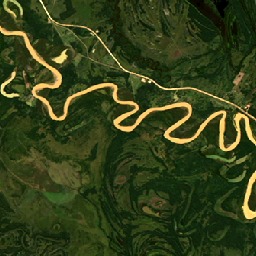
- Dostępność zbioru danych
- 2013-04-11T00:00:00Z–2025-12-27T23:19:13Z
- Dostawca zbioru danych
- NASA LP DAAC
- Tagi
Opis
Projekt Harmonized Landsat Sentinel-2 (HLS) dostarcza spójne dane dotyczące odbicia światła słonecznego od powierzchni i jasności na szczycie atmosfery z wirtualnej konstelacji czujników satelitarnych. Instrument Operational Land Imager (OLI) znajduje się na pokładzie satelitów Landsat 8 i Landsat 9, które są wspólnym projektem NASA i USGS, a instrument Multi-Spectral Instrument (MSI) jest zamontowany na pokładzie europejskich satelitów Copernicus Sentinel-2A i Sentinel-2B. Połączone pomiary umożliwiają globalne obserwacje powierzchni Ziemi co 2–3 dni w rozdzielczości przestrzennej 30 m. Projekt HLS wykorzystuje zestaw algorytmów do uzyskiwania spójnych produktów z instrumentów OLI i MSI, które obejmują korekcję atmosferyczną, maskowanie chmur i cieni chmur, przestrzenną korejestrację i wspólne siatki, normalizację oświetlenia i kąta widzenia oraz dostosowanie pasma spektralnego.
Projekt HLS rozpowszechnia dane w postaci 2 osobnych produktów: HLSL30 (Landsat 8/9) i HLSS30 (Sentinel-2 A/B). Oba produkty zapewniają 30-metrową funkcję dwukierunkowego rozkładu odbicia (BRDF) w punkcie nadiru oraz skorygowane odbicie (NBAR).
Dokumentacja:
Pasma
Rozmiar piksela
30 metrów
Pasma
| Nazwa | Jednostki | Rozmiar piksela | Opis | ||||||||||||||||||||||||||||||||||||||||||||||||||||||||||||||||||||||||||||||||||||||||||||||||
|---|---|---|---|---|---|---|---|---|---|---|---|---|---|---|---|---|---|---|---|---|---|---|---|---|---|---|---|---|---|---|---|---|---|---|---|---|---|---|---|---|---|---|---|---|---|---|---|---|---|---|---|---|---|---|---|---|---|---|---|---|---|---|---|---|---|---|---|---|---|---|---|---|---|---|---|---|---|---|---|---|---|---|---|---|---|---|---|---|---|---|---|---|---|---|---|---|---|---|---|
B1 |
metry | Coastal Aerosol |
|||||||||||||||||||||||||||||||||||||||||||||||||||||||||||||||||||||||||||||||||||||||||||||||||
B2 |
metry | Niebieski |
|||||||||||||||||||||||||||||||||||||||||||||||||||||||||||||||||||||||||||||||||||||||||||||||||
B3 |
metry | Zielony |
|||||||||||||||||||||||||||||||||||||||||||||||||||||||||||||||||||||||||||||||||||||||||||||||||
B4 |
metry | Czerwony |
|||||||||||||||||||||||||||||||||||||||||||||||||||||||||||||||||||||||||||||||||||||||||||||||||
B5 |
metry | NIR |
|||||||||||||||||||||||||||||||||||||||||||||||||||||||||||||||||||||||||||||||||||||||||||||||||
B6 |
metry | SWIR1 |
|||||||||||||||||||||||||||||||||||||||||||||||||||||||||||||||||||||||||||||||||||||||||||||||||
B7 |
metry | SWIR2 |
|||||||||||||||||||||||||||||||||||||||||||||||||||||||||||||||||||||||||||||||||||||||||||||||||
B9 |
metry | Cirrus |
|||||||||||||||||||||||||||||||||||||||||||||||||||||||||||||||||||||||||||||||||||||||||||||||||
B10 |
metry | TIRS1 |
|||||||||||||||||||||||||||||||||||||||||||||||||||||||||||||||||||||||||||||||||||||||||||||||||
B11 |
metry | TIRS2 |
|||||||||||||||||||||||||||||||||||||||||||||||||||||||||||||||||||||||||||||||||||||||||||||||||
Fmask |
metry | Fragmenty wysokiej jakości |
|||||||||||||||||||||||||||||||||||||||||||||||||||||||||||||||||||||||||||||||||||||||||||||||||
SZA |
deg | metry | Kąt zenitu słonecznego |
||||||||||||||||||||||||||||||||||||||||||||||||||||||||||||||||||||||||||||||||||||||||||||||||
SAA |
deg | metry | Kąt azymutu Słońca |
||||||||||||||||||||||||||||||||||||||||||||||||||||||||||||||||||||||||||||||||||||||||||||||||
VZA |
deg | metry | Wyświetlanie kąta zenitalnego |
||||||||||||||||||||||||||||||||||||||||||||||||||||||||||||||||||||||||||||||||||||||||||||||||
VAA |
deg | metry | Wyświetlanie kąta azymutu |
||||||||||||||||||||||||||||||||||||||||||||||||||||||||||||||||||||||||||||||||||||||||||||||||
Właściwości obrazu
Właściwości obrazu
| Nazwa | Typ | Opis |
|---|---|---|
| ACCODE | CIĄG ZNAKÓW | Wersja LaSRC, np. LaSRCS2AV3.5.5 lub LaSRCL8V3.5.5 |
| LANDSAT_PRODUCT_ID | CIĄG ZNAKÓW | Identyfikator produktu sceny wejściowej L1 z satelity Landsat 8 na potrzeby przetwarzania śledzenia wstecznego. |
| TIRS_SSM_MODEL | CIĄG ZNAKÓW | Model pozycji kodera TIRS SSM (wstępny, ostateczny lub rzeczywisty). |
| TIRS_SSM_POSITION_STATUS | CIĄG ZNAKÓW | L30 |
| USGS_SOFTWARE | CIĄG ZNAKÓW | LPGS_2.6.2 |
| CLOUD_COVERAGE | LICZBA ZMIENNOPRZECINKOWA O PODWÓJNEJ PRECYZJI | Procent chmur i cieni chmur w obserwacji na podstawie Fmask |
| HLS_PROCESSING_TIME | CIĄG ZNAKÓW | data i godzina przetwarzania HLS dla tej obserwacji; |
| MEAN_SUN_AZIMUTH_ANGLE | LICZBA ZMIENNOPRZECINKOWA O PODWÓJNEJ PRECYZJI | Średni kąt azymutalny słońca w stopniach dla danych wejściowych HLS L30 |
| MEAN_SUN_ZENITH_ANGLE | LICZBA ZMIENNOPRZECINKOWA O PODWÓJNEJ PRECYZJI | Średni kąt zenitalny słońca w stopniach dla danych wejściowych HLS L30 |
| MEAN_VIEW_AZIMUTH_ANGLE | LICZBA ZMIENNOPRZECINKOWA O PODWÓJNEJ PRECYZJI | Średni kąt azymutalny obserwacji w stopniach dla danych wejściowych |
| MEAN_VIEW_ZENITH_ANGLE | LICZBA ZMIENNOPRZECINKOWA O PODWÓJNEJ PRECYZJI | Średni kąt zenitalny obserwacji w stopniach dla danych wejściowych |
| NBAR_SOLAR_ZENITH | LICZBA ZMIENNOPRZECINKOWA O PODWÓJNEJ PRECYZJI | Kąt zenitu słonecznego użyty do obliczenia NBAR |
| SPATIAL_COVERAGE | LICZBA ZMIENNOPRZECINKOWA O PODWÓJNEJ PRECYZJI | Procent kafelka z danymi |
Warunki korzystania z usługi
Warunki usługi
NASA promuje pełne i otwarte udostępnianie wszystkich danych społecznościom badawczym i związanym z aplikacją, sektorowi prywatnemu, środowisku akademickiemu i ogółowi społeczeństwa.
Cytaty
Masek, J., Ju, J., Roger, J., Skakun, S., Vermote, E., Claverie, M., Dungan, J., Yin, Z., Freitag, B., Justice, C. (2021). HLS Operational Land Imager Surface Reflectance and TOA Brightness Daily Global 30m v2.0 [Zbiór danych]. NASA EOSDIS Land Processes Distributed Active Archive Center. Dostęp: 12.09.2023 r., https://doi.org/10.5067/HLS/HLSL30.002
DOI
Odkrywaj za pomocą Earth Engine
Edytor kodu (JavaScript)
var collection = ee.ImageCollection("NASA/HLS/HLSL30/v002") .filter(ee.Filter.date('2013-04-25', '2013-04-28')) .filter(ee.Filter.lt('CLOUD_COVERAGE', 30)); var visParams = { bands: ['B4', 'B3', 'B2'], min:0.01, max:0.18, }; var visualizeImage = function(image) { var imageRGB = image.visualize(visParams); return imageRGB; }; var rgbCollection = collection.map(visualizeImage); Map.setCenter(-60.1765, -22.5318, 11) Map.addLayer(rgbCollection, {}, 'HLS RGB bands');
